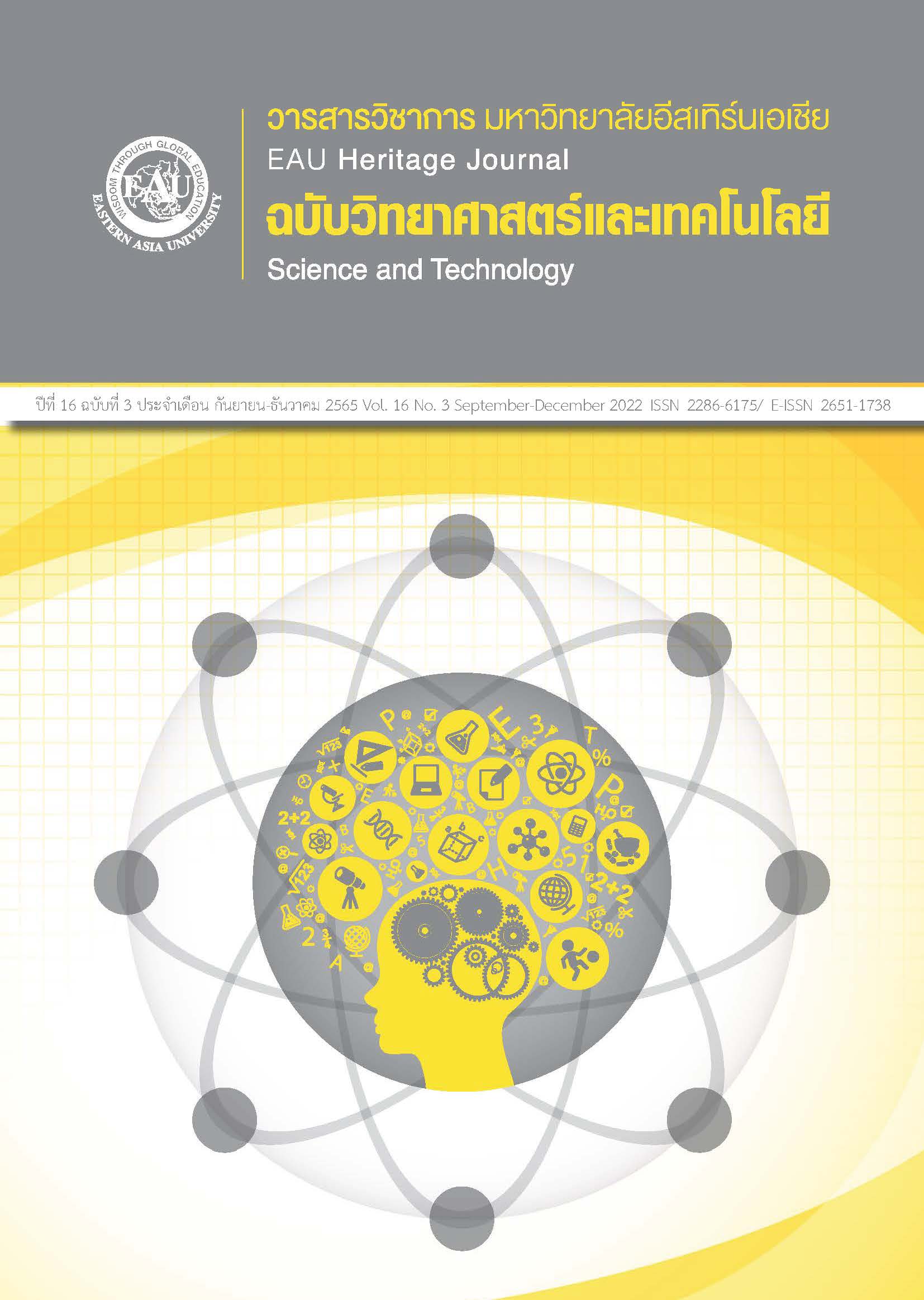การจัดลำดับความสำคัญของปัจจัยที่มีผลต่อประสิทธิภาพการจัดการ ด้านความปลอดภัยในการทำงานของพนักงานท่าอากาศยานนานาชาติเชียงใหม่
คำสำคัญ:
การจัดการด้านความปลอดภัย, การจัดลำดับ, กระบวนการลำดับชั้นเชิงวิเคราะห์บทคัดย่อ
การวิจัยครั้งนี้มีวัตถุประสงค์เพื่อ (1) ศึกษาปัจจัยที่มีผลต่อประสิทธิภาพการจัดการด้านความปลอดภัยในการทำงานของพนักงานท่าอากาศยานนานาชาติเชียงใหม่ (2) ศึกษาลำดับความสำคัญของปัจจัยที่มีผลต่อประสิทธิภาพการจัดการด้านความปลอดภัยในการทำงานของพนักงานท่าอากาศยานนานาชาติเชียงใหม่ กลุ่มตัวอย่างครั้งนี้ที่ใช้ในการวิจัย คือ ผู้เชี่ยวชาญด้านความปลอดภัยในการทำงาน จำนวน 10 คน โดยใช้การสุ่มตัวอย่างแบบเจาะจง เครื่องมือที่ใช้ในการเก็บรวบรวมข้อมูล คือ แบบสอบถาม สำหรับการวิเคราะห์ข้อมูลในงานวิจัยครั้งนี้ คือ สถิติพรรณนา และใช้เทคนิคกระบวนการลำดับชั้นเชิงวิเคราะห์ ผลการวิจัยพบว่า (1) ปัจจัยที่มีผลต่อประสิทธิภาพการจัดการด้านความปลอดภัยในการทำงานของพนักงานท่าอากาศยานนานาชาติเชียงใหม่ จำนวน 7 ปัจจัย ได้แก่ ความมุ่งมั่นและความเข้มแข็งของผู้บริหารในการจัดการความปลอดภัย การฝึกอบรม การสื่อสาร การจัดสภาพแวดล้อมให้เหมาะสมกับการทำงานนโยบายความปลอดภัยและการบริหารจัดการความปลอดภัย การให้ความสำคัญเรื่องความปลอดภัย และระดับการรับรู้ความปลอดภัย ความเสี่ยงและสิ่งที่เป็นอันตราย และ (2) ปัจจัยที่มีผลต่อประสิทธิภาพการจัดการด้านความปลอดภัยในการทำงานของพนักงานท่าอากาศยานนานาชาติเชียงใหม่สูงที่สุด 3 อันดับแรก ได้แก่ (1) ความมุ่งมั่นและความเข้มแข็งของผู้บริหารในการจัดการความปลอดภัย (0.255) (2) การฝึกอบรม (0.199) และ (3) การสื่อสาร (0.142)
เอกสารอ้างอิง
Airports of Thailand Public Co.,Ltd. (2020). Annual report 2020. Retrieved from https://bit.ly/3Fo0dbg. (in Thai)
Aumnuaiworachai, K., & Wessapan, T. (2017). The relationships between safety climate and at risk behavior of employee working at Chiang Mai International Airport. EAU Heritage Journal Science and Technology, 11(3), 99-111. (in Thai)
Bosak, J., Coetsee, W. J., & Cullinane, S. J. (2013). Safety climate dimensions as predictors for risk behavior. Accident; Analysis and Prevention, 55, 256–264. https://doi.org/10.1016/j.aap.2013.02.022
Chan, A., Kwok, W. Y., & Duffy, V. (2004). Using AHP for determining priority in a safety management system. Industrial Management & Data Systems, 104(5), 430-445. https://doi.org/10.1108/02635570410537516
Cheyne, A., Cox, S., Oliver, A., and Tomas, J. (1998). Safety culture: The prediction of commitment to safety in the manufacturing industry. British Journal of Management, 9(s1), 3-11. doi: 10.1111/1467-8551.9.s1.2
Cooper, M. D., & Phillips, R. A. (2004). Exploratory analysis of the safety climate and safety behavior relationship. Journal of safety research, 35(5), 497–512. https://doi.org/10.1016/j.jsr.2004.08.004
Diaz, R., & Cabrera, D. (1996). Safety climate and attitude as evaluation measures of organizational safety. Accident Analysis and Prevention, 29(5), 643-650. https://doi.org/10.1016/s0001-4575(97)00015-8
Hagquist, R. F. (1994). High-precision prioritization using analytic hierarchy process: Determining state HPMS component weighting factors. Transportation Research Record, 1429(1), 7-14. https://jglobal.jst.go.jp/en/detail?JGLOBAL_ID=200902136824115134&rel=0
Health and Safety Executive. (2005). Health and safety statistics2005/06. Retrieved from http://www.hse.gov.uk/statistics/overall/hssh0506.pdf
Khongcharoen, N. (2013). Thai Standard Industrial 18001: 2011. Retrieved from https://www.gotoknow.org/posts/534965. (in Thai)
Kookaew, J. (2011). Success factors for occupational health and safety management: A case study in a frozen food business. Retrieved from http://digi.library.tu.ac.th/thesis/pb/0030/01title-illustrations.pdf. (in Thai)
Pansamut, R., Sthapitanonda, S., & Rujopakarn, W. (2017). Factors affecting safety climate in building construction. In Proceedings of 52nd Kasetsart University Annual Conference: Architecture and Engineering (pp. 322-329). Bangkok: Kasetsart University. (in Thai)
Saaty, T. (1980). The analytical hierarchy process. McGraw Hill: New York.
SGS Thailand Limited. (2009). Occupational Health and Safety Management System (OHSAS 18001) for manufacturers and deliveries in the automotive industry. Retrieved from https://www.tpa.or.th/publisher/pdfFileDownloadS/fq141_p58-60.pdf. (in Thai)
Somsuk, N., & Huangsuwan, S. (2019). Ranking of the barriers to airline passengers adaption of self-service technologies using Analytical Hierarchy Process. EAU Heritage Journal Science and Technology, 13(1), 1-15. (in Thai)
Somsuk, N., Pookboonmee, V., Huangsuwan, S., Sakulkrit, K., Nakha, S., & Saikhoone, S. (2021). Application of AHP method to cargo airline selection for air freight forwarder. EAU Heritage Journal Science and Technology, 15(1), 218–234. (in Thai)
Suebsub, C. (2012). Employee safety management in Thai refrigeration industry. Bangkok: Panyachon Distributor. (in Thai)
Sutummasa, S., Buayam, S., & Bavornthammarat, A. (2007). Occupational health and safety & waste management in industry. Bangkok: Sukhothai Thammathirat Open University. (in Thai)
Suwan, T. (2011). Relationships between perception safety in working and job related injuries of labour: Case study U-ngoen Co., Ltd. (Master’s thesis). King Mongkut’s University of Technology North Bangkok. Bangkok. (in Thai)
Tansirikhongkon, V. (2014). AHP Advanced decision making for organizational advancement and public well-being. Bangkok: Chulalongkorn University Book Center. (in Thai)
The Thailand Research Fund. (2017). Guidelines for driving towards as regional air cargo hub. Retrieved from http://www.tafathai.org/upload_images/file/Air%20Cargo%20Seminar%20summary%2027.10.17.pdf. (in Thai)
Yoosook, W. (2001). Occupational health and safety. Bangkok: Department of Occupational Health and Safety, Faculty of Public Health, Mahidol University. (in Thai)
Zohar, D. (1980). Safety climate in industrial organizations: Theoretical and applied implications. Journal of Applied Psychology, 65, 96-102. doi:10.1037/0021-9010.65.1.96







